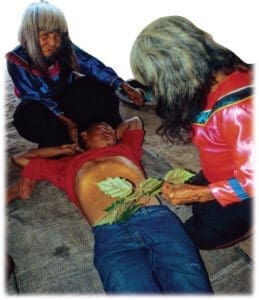A scientist was quoted as saying “Each time a medicine man dies, it is as if a library has been burned down. There is much yet to be learned from local shamans, yet their individual and cultural survival is seriously threatened as modern loggers, miners, multinational corporations, and landless farmers invade and decimate the forest.”1 As holders of so much expertise, why is the shaman’s future in danger?
The Amazon is the world’s largest rainforest, encompassing over 3 million square miles of land. We believe the area is home to over 300,000 different breeds of plants, yet because of the expanse, the challenging terrain, and the remote location only about 40% have been discovered. With so much about this area remaining unknown, we rely on the expertise of local shamans to understand the potential power growing within the Amazonian botanicals.
Indigenous Society’s Shaman
 For an indigenous society, the shaman is the individual responsible for holding medicinal knowledge of the environment surrounding the village. In an article published by Rhett Butler, he notes that no one really knows how shamans originally gained their expertise. “Most say trial and error. Native forest dwellers say the knowledge was bestowed upon them by spirits of the rainforest.”2 Regardless, shamans combined spirituality with botanicals to provide potential remedies for a myriad of health conditions.
For an indigenous society, the shaman is the individual responsible for holding medicinal knowledge of the environment surrounding the village. In an article published by Rhett Butler, he notes that no one really knows how shamans originally gained their expertise. “Most say trial and error. Native forest dwellers say the knowledge was bestowed upon them by spirits of the rainforest.”2 Regardless, shamans combined spirituality with botanicals to provide potential remedies for a myriad of health conditions.
Shaman’s Future Starts to be Impacted
When American evangelical missionaries first began to explore areas of the Amazon rainforest in the 1960’s, tribes were persuaded to alter their rituals. There is evidence that in as early as 1963, tribes in the area now known as Suriname abandoned traditional dances, festivals and oral traditions. In fact, shamanism came under attack as early missionaries viewed their work as “witchcraft.” For the Carib tribes, the use of tobacco, rattles, and chants in healing ceremonies was discontinued. While missionaries felt the use of medicinal plants was compatible with Christianity, they still did not encourage their use.3
Shaman’s Future Threatened
Today, there are new threats for the future of shamans in the Amazon. Newer generations in these areas don’t see the same importance for ancient wisdom as their ancestors did. Young adults are choosing to develop careers in conventional medicine instead of learning traditional methodologies. Another challenge is that fewer people are continuing to speak native languages, which means that knowledge that has been passed down through generations in oral traditions will begin to be lost forever.4
Explore Herbs America to Learn More
Join us as we uncover what indigenous people have known for centuries: the Amazon Basin and Andes Mountains are home to a veritable living pharmacy of healing botanicals.
Visit our online Botanical Encyclopedia to learn about various botanicals we’ve discovered in our explorations, all of which are now easily available to you in our online store.
“Medicinal Treasures of the Rainforest,” Adventure Life. Published online at: https://www.adventure-life.com/amazon/articles/medicinal-treasures-of-the-rainforest ↩
Butler, Rhett A. “How did rainforest shamans gain their boundless knowledge on medicinal plants?” Mongabay. May 14, 2005. Published online at: https://news.mongabay.com/2005/05/how-did-rainforest-shamans-gain-their-boundless-knowledge-on-medicinal-plants/#:~:text=Native%20forest%20dwellers%20say%20the,relatively%20short%20period%20of%20time. ↩
Herndon, C.N., Uiterloo, M., Uremaru, A. et al. “Disease concepts and treatment by tribal healers of an Amazonian forest culture.” J Ethnobiology Ethnomedicine 5, 27 (2009). https://doi.org/10.1186/1746-4269-5-27 ↩
Rittenhouse, Madison. “Amazonian Shamans Bring Hope for the Future: Potential for Billions Worth of Medical Cures.” Pimsleur. Published online at: https://blog.pimsleur.com/2019/08/13/amazonian-shaman-healing-cures-medicines/ ↩

Reader Interactions